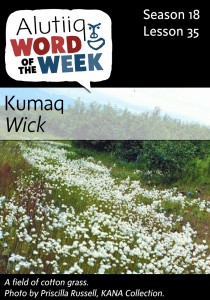 Kumaq – Wick
Kumaq – Wick
Kumaq kuakaskameng tamleritaartuq. – The wick always gets black after it burns.
Stone lamps filled with sea mammal oil once illuminated and heated Alutiiq homes with the aid of small wicks twisted from plant fibers. Many different plants could serve this purpose. Kodiak’s early Russian colonists noted lamps fitted with grass wicks. Alutiiq people also used clumps of moss and tufts of cotton grass to fashion wicks, as both materials absorb oil well.
Cotton grass (Eriophorum spp.) is sedge that grows in a wide range of wet habitats. There are three varieties in the Kodiak region. Cotton grass blooms in summer, creating an easily identifiable white, fluffy seed head that resembles cotton, as well as narrow, grass-like leave that rise from its base. Elders remember rolling several tufts of the cotton to create an absorbent wick that burned gradually.
The wick is an ancient piece of Alutiiq technology. Although plant fibers are seldom preserved in prehistoric sites, archaeologists know that Kodiak’s earliest residents used them. Settlements over 7,000 years have produced lamps with soot-blackened rims. They were charred as a burning wick consumed the seal, sea lion, or whale oil within.
Source: Alutiiq Museum [xyz-ihs snippet=”Adsense-responsive”]
